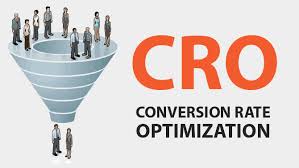
Conversion Rate Optimization (CRO) is the science and art of increasing the percentage of website visitors who take a desired action, whether that’s making a purchase, signing up for a newsletter, or filling out a contact form. In today’s competitive digital landscape, CRO has become essential for businesses looking to maximise their online presence and drive meaningful results.
Simply driving traffic to your website is not enough; converting that traffic into loyal customers is what ultimately drives business success. By focusing on CRO, businesses can fine-tune their online strategies to enhance user experience, increase engagement, and ultimately boost conversions.
Effective CRO involves a combination of data analysis, user research, and continuous testing. By understanding user behaviour through tools like heatmaps and session recordings, businesses can identify pain points in the conversion process and make informed decisions to improve it.
CRO is not a one-time task but an ongoing process of refinement and optimisation. By continuously monitoring performance metrics, conducting experiments, and adapting strategies based on insights gained, businesses can stay ahead in the competitive digital landscape.
Conversion Rate Optimization is a powerful tool that empowers businesses to maximise their online potential and drive tangible results. By prioritising user experience, data-driven decision-making, and continuous improvement, businesses can unlock new opportunities for growth and success in the digital realm.
To enhance your conversion rate optimisation efforts, it is crucial to meticulously analyse your website data to pinpoint areas that require enhancement. By delving into metrics such as bounce rates, click-through rates, and user flow patterns, you can gain valuable insights into user behaviour and identify potential bottlenecks in the conversion process. This data-driven approach enables you to make informed decisions on where to focus your optimisation efforts, ultimately leading to a more streamlined and effective user experience that drives higher conversion rates.
Ensuring that your website is user-friendly and easy to navigate is a crucial aspect of conversion rate optimization. A seamless user experience not only enhances engagement but also guides visitors towards the desired actions, ultimately increasing conversion rates. By prioritising intuitive design, clear navigation paths, and responsive functionality, businesses can create a positive interaction with their audience, leading to higher conversions and improved overall performance.
To enhance conversion rate optimization, it is crucial to utilise clear and compelling call-to-action buttons on your website. These buttons serve as a direct prompt for visitors to take the desired action, whether it’s making a purchase, signing up for a newsletter, or contacting the business. By ensuring that your call-to-action buttons are prominently displayed, visually appealing, and feature persuasive language, you can guide users towards conversion and improve overall engagement on your site.
To enhance your website’s conversion rate, it is crucial to implement Tip 4: Test different versions of your website elements to see what works best. By conducting A/B testing and experimenting with variations of key elements such as call-to-action buttons, headlines, and layout designs, you can gain valuable insights into what resonates most with your audience. This data-driven approach allows you to make informed decisions to optimise your website for higher conversions and improved user engagement.
To enhance your conversion rates, it is crucial to optimise your landing pages effectively. A well-crafted landing page that is tailored to guide visitors towards the desired action can significantly impact conversion rates. By focusing on elements such as clear and compelling call-to-actions, engaging content, intuitive design, and fast loading times, businesses can create a seamless user experience that encourages conversions. Optimising landing pages ensures that visitors are more likely to take the desired action, ultimately driving better results for your business.
By simplifying the checkout process, businesses can effectively reduce cart abandonment rates and improve conversion rates. Streamlining the steps required for customers to complete their purchase not only enhances user experience but also minimises friction points that may deter potential buyers. By optimising the checkout process with clear instructions, minimal form fields, and easy payment options, businesses can encourage more seamless transactions and increase the likelihood of customers completing their purchases successfully.
Utilising customer reviews and testimonials is a powerful strategy in conversion rate optimisation. By showcasing positive feedback from satisfied customers, businesses can build trust with website visitors and instil confidence in their products or services. Genuine reviews act as social proof, reassuring potential customers and encouraging them to take the desired action, whether it’s making a purchase or signing up for a service. Incorporating authentic testimonials into the website can significantly influence conversion rates by highlighting the credibility and reliability of the business, ultimately leading to increased conversions and customer loyalty.
Implementing A/B testing is a crucial tip in the realm of conversion rate optimization. By comparing different strategies through controlled experiments, businesses can gather valuable insights and make informed, data-driven decisions to enhance their online performance. A/B testing allows companies to identify which variations resonate best with their audience, ultimately leading to improved conversion rates and a more effective digital strategy.
To enhance your conversion rate optimization efforts, it is crucial to continuously monitor and adjust your strategies based on performance metrics. By regularly analysing key metrics such as conversion rates, bounce rates, and user engagement, you can gain valuable insights into the effectiveness of your current strategies. This data-driven approach allows you to identify areas for improvement, experiment with new tactics, and adapt your tactics to better meet the needs and preferences of your target audience. Embracing a cycle of monitoring and adjustment ensures that your CRO efforts remain dynamic and responsive to changing market trends, ultimately leading to improved conversions and business success.